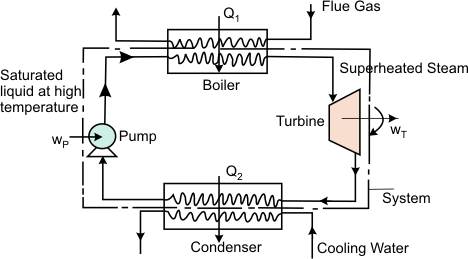| |
Heat Engine
- A heat engine is a device which converts the energy it receives at heat, into work.
- It is a cyclically operating device.
- It receives energy as heat form a high temperature body, converts part of it into work and rejects the rest to a low temperature body.
- A thermal power plant is an example of a heat engine.

Figure 16.1 Figure 16.1 describes a basic arrangement of a thermal power plant
- In the boiler, the working fluid receives a certain amount of heat
 from the hot combustion products. from the hot combustion products.
- The superheated steam enters a turbine where it undergoes expansion performing the shaft work
 . .
- The low pressure steam enters a condenser where it exchange energy as heat at constant pressure with the cooling water and emerges as the condensate. The condensate rejects a certain amount of heat
 to the cooling water. to the cooling water.
- The low pressure condensate from the condenser enters the pump. Work
 is done on the pump to elevate the condensate to the boiler pressure and return it to the boiler. is done on the pump to elevate the condensate to the boiler pressure and return it to the boiler.
In the above example,
Work done by the system  Energy absorbed as heat by the system 
Energy rejected as heat by the system 
According to first law of thermodynamics, the heat and work interaction are related by the equation.
 |
(16.1) |
Finally, the thermal efficiency  of a heat engine can be expressed as of a heat engine can be expressed as
or,
 |
(16.2) |
|